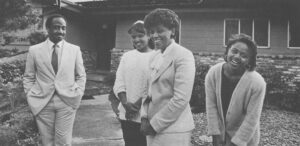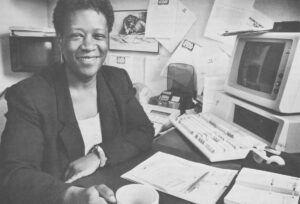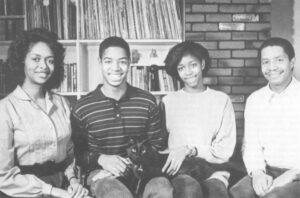KNOXVILLE, Tenn.-It was a long way from the old neighborhood in mostly black south-side Chicago. On a recent Saturday afternoon in a Knoxville suburb, Edye Ellis glanced up from her kitchen table, paused between bites of a turkey sandwich and watched as a neighbor’s cow ran across her wide freshly cropped lawn. Ellis’ two gardeners, a white man and woman, shouted in accents reminiscent of guitar twangs, and gave chase.
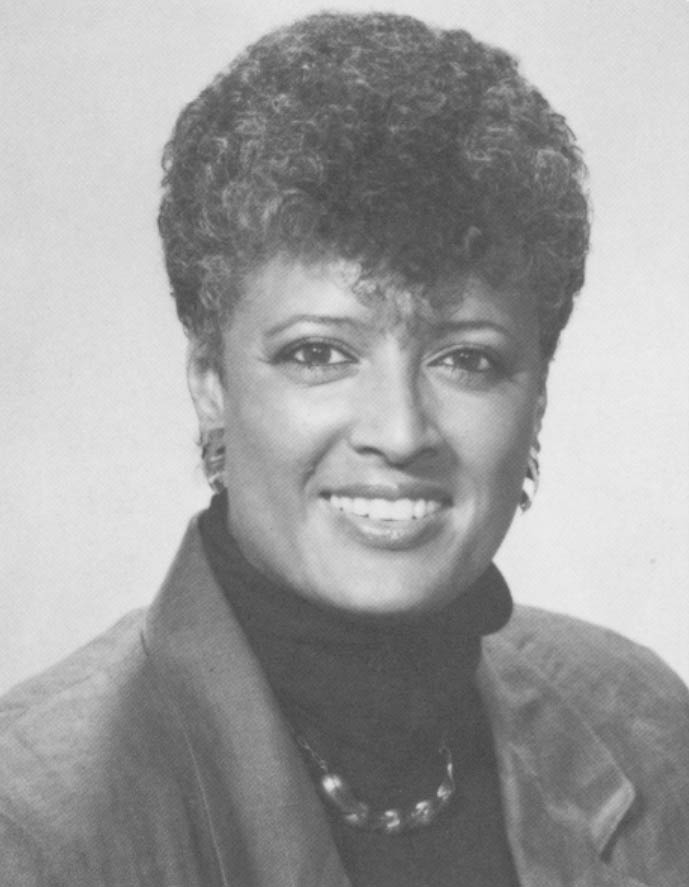
Ellis excused herself, walked past the hand-carved African masks decorating her living room walls, and coolly viewed the scene from her porch.
“As a black professional,” Ellis said later, “you have to be willing to be very adventurous.”
Ellis, 42, the director of publicity at the University of Tennessee, lives in Norris, where other black faces are scarce. There are other differences, also. The white neighbors, to the right of her split rail wooden fence, are farmers. Those across the road run the Museum of Appalachia, a storehouse of hillbilly memorabilia.
But these differences are not enough to make Ellis feel uncomfortable. She loves the challenge of her work, which includes directing a staff of nine as they write and edit informational brochures and pamphlets and handle media inquiries for the 25,000-student body institution. Ellis said she also enjoys the beauty of Tennessee’s mountainous terrain. When questioned about cultural isolation, Ellis pointed to her heart. “You learn to take your culture with you,” she said.
Ellis is one of thousands of blacks who have moved south in recent years. They come to fill positions of authority in new and growing corporations and institutions, many which have prospered as the American economy has shifted from heavy industry and manufacturing, to high technology and services. Protected by civil rights laws and their self esteems bolstered by marketable college degrees, these professionals are moving to cities and towns which only a decade ago might have seemed too racially intolerant to abide.
But even with their new found self-confidence and legislative armor, they are wary. The legacies of racial discrimination, which the South inherited, cannot simply be buried beneath the soil of new office buildings. In fact, it is against the backdrop of the South’s social history that a new dilemma is posed for the black professional. Will they accept job offers in these regions, and perhaps subject themselves and their families to open hostility from neighbors and co-workers? Or, will they limit their careers by ruling out entire geographical areas?
Slowly, increasingly blacks are taking the chance.
Metallurgical engineer Sylvester Scott, 46, originally of Rockford, Illinois, moved to Knoxville in 1983, as a manager for the Aluminum Company of America. This was the fourth promotion for Scott. He, his wife Carol, and their two teenage children, have lived in Pittsburgh, Boise and Washington, DC. The family agreed that most of the moves required cultural adjustments. But Scott believes it is important to accept the promotions and transfers that go with the job. As one of the black pioneers in his profession he is ever mindful that he is paving the way for others who will come after him.
“We’re part of the transient phenomenon of black professionals,” said Scott. “Most of the others we’ve met here have all come from someplace else.”
Once a month, Scott and his wife attend social affairs sponsored by a group of black professionals who have also come from different cities.
Ellis belongs to a similar social organization. Her club is comprised of black professional women who hail from around the country. She too has had a career of many moves, including Minnesota, Ohio and Kentucky.
“The black community can’t afford to be too insulated,” said Ellis. “We often don’t like to go outside boundaries. But in many cases the only boundaries we’re faced with are the ones inside of us.”
Ellis and the Scotts are part of a pattern which marks a reversal in the decades-old migratory movement when millions of blacks–skilled and unskilled–headed north to escape racial injustice.
Today, black professionals going south represent only a trickle compared to the number who left after the 1920’s, according to Kenneth Cory, director of the Beck Cultural Center, a black historical institute based in Knoxville. Furthermore, they represent a very small number among all professionals who have moved south with American businesses. For decades, blacks continued to head north.
“The South lost black lawyers, doctors, dentists and business people,” said Cory. He added that the region also lost the future offspring of these professionals, many who would eventually make up a large part of today’s black professional class.
The black movement north has not entirely come to an end. According to the United States Census Bureau, while the white collar work force in Tennessee grew by 80,000 between 1983 and 1985, the state lost 6,000 black professional workers during the same period.
Those who are returning to the South, and those natives who remained, are of increasing importance. Their experiences may make a difference, not only to other black professionals who are waiting and watching. but to the nation as a whole. For they are social barometers, indicators of how a region can shake itself free of burdensome reputations, and move on toward the future.
I chose Tennessee and specifically the city of Knoxville because it has been dramatically affected by the move toward the Sunbelt. Geographically, Tennessee was in the right place at the right time. Only a day’s drive or short flight from major eastern and mid-western cities, it has become a major market center.
In 1982, the Worlds Fair in Knoxville symbolized for many the changes that had occurred and were to come. Of course, some aspects are unchanged. Wrestling is still a favored sport and Daniel Boone is a local hero. But downtown, gleaming superstructures stretch toward a seemingly limitless skyline, giving testimony to business growth. Much of the growth is attributable to the University of Tennessee, one of the nation’s largest land grant universities, and the Tennessee Valley Authority (TVA), the biggest power company in the world. Chosen as one of the most livable cities in the United States in an independent study in 1984, Knoxville housing prices have remained relatively stable and its streets are safe and clean.
Knoxville’s black population is statistically similar to black populations in many mid-sized cities throughout the South. Of 175,000 residents, 13 percent (22,750) are blacks. According to Ernestine Moore, secretary for the local chapter of Links, a National black social organization, about 2 1/2 percent (560) of the black population is professional. Of those, about half are natives of Knoxville.
It has been said that if a black can relocate and prevail in eastern Tennessee, he can do so anywhere. A stronghold of Republican conservatism, it is also the land of the Hatfields and McCoys. Fierce regionalism persists. The unwritten code, which dictates that outsiders are not to be trusted, makes it very difficult for blacks to settle in. Looming still larger, however, are charges of racism.
At first glance, Knoxville’s history seems very different from that of the deep South. During the Civil War, most whites in eastern Tennessee were sympathetic with the North. But that stance may have had much to do with the Appalachian economy. Because of the mountainous terrain, there were no cotton crops. In 1867 the state legislature granted black men the right to vote and two years later they began serving in county court and on the city council. This lasted until 1912 when a fifty year period of Jim Crow laws commenced.
Harry Gillespie, now 57, remembered, as a boy, seeing a mob attack a black man who had been spotted with a white woman. “I was working at the bus station. I was just a kid, but I can still hear his screams,” said Gillespie.
Gillespie would eventually put his ugly memories behind him. In the late ’60s, when blacks once again began running for, and being appointed to public office, Gillespie became the first black county supervisor. Later he was appointed the first black assistant superintendent of city schools.
Now retired, Gillespie said changes in Knoxville have not been substantive as much as they have been palliative. He regrets not having moved north when he had the opportunity.
“When I graduated from college, I had 15 job offers from around the country,” said Gillespie, who taught high school chemistry. “But it was 1952 and there was a war going on. I had some influence here with the local draft board and I was afraid if I moved someplace else I’d get drafted.”
Gillespie said when he took the superintendent’s job in 1975, several white co-workers told him they did not think he could handle the job. And time brought no détente. He said he was in constant emotional skirmishes with white employees. Five years ago he suffered a stroke. Weakened, he retired at 52. Today he is bitter. He thinks the resistance and hostility he encountered on the job damaged his health. He believes his decision not to go north cost him 10 years of his professional life.
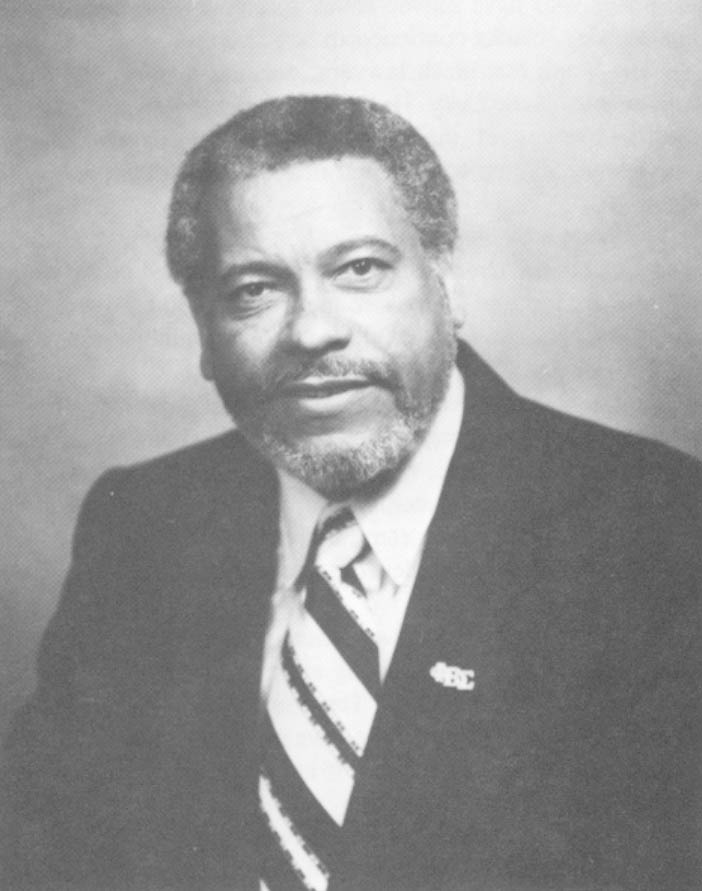
Gillespie’s view of regions outside the south as being easier places for blacks to survive, is one that is shared by many. Robert Booker, 51, who grew up in Knoxville, said he learned otherwise. When offered a job with a large corporation in Detroit in 1974, he accepted. However, he became quickly disenchanted with his company’s attitude toward the black community, and his own experiences in the new city.
“I ran into more prejudice there than here,” said Booker. “One bar I went to had a peephole and I had to ring to get in. When the host looked out and saw me standing there he closed the door in my face.” Booker returned to Knoxville in 1976, where he works as an administrative aide to the mayor.
Today, Booker said he is running into an increasing number of former classmates who had moved north after graduation but who are now returning to live and work in Knoxville.
“They’re coming home,” said Booker. He added, however, that for most blacks, the perception of the south as a wild and lawless region for minorities, is one that persists.
“A friend came to visit me from Ohio and acted paranoid. He complained that white people were staring at him. It was his first time in the South, and he acted as if he could get lynched any minute.”
LaNell Robinson, 25, used to think more favorably of the South. She too was born and raised in Knoxville. She grew up hearing the story of her aunt, a chemist who 30 years ago moved to New York to work in a large chemical company. Bitter about racism, the aunt vowed never to return to Tennessee. She kept her vow and eventually lost touch with her family.
Robinson thought her life would be different from her aunt’s. Educated in interracial high schools, in 1981, she earned a degree in financing from the University of Tennessee. Afterwards, she said she spent several months looking for work in her field, while she kept hearing of white classmates who were getting hired by big companies. Robinson said employers told her she didn’t have enough experience. Determined, she moved to Los Angeles in 1983 and worked as a director of a corporate real estate company, a job she held for three years. Last summer Robinson was back in Knoxville looking for work. But six months was enough to convince her that life has changed for relatively few blacks in the South; those, she said, who work in highly specialized fields.
“Everyone who interviewed me in Knoxville admitted that I’m qualified and that I have the experience. But the only jobs they offered me were for secretaries, clerks or word processors,” said Robinson.
Last fall, she returned to Los Angeles. A company that had heard about her work recruited her.
At least one man. Frances LeVert, 45, a nuclear engineer, believes racism is not confined to one geographic region. He has recently changed his life based on that assumption. Originally from Birmingham, Alabama, LeVert has lived in Michigan, Pennsylvania and Illinois. “Racism is endemic in America. The people I moved to Knoxville to work with were young, white professionals… liberals. But when I scratched the surface, I found they were also bigoted,” said LeVert.
Two years ago, LeVert started his own consulting firm in Knoxville. At the moment, he is knee deep in research for the Navy on sensor development. But his business doesn’t offer the kind of security his old job gave him.
“I won’t take those set aside contracts that the government gives to minorities. I don’t like that whole notion. I want my firm to survive based on its ability to perform the job best.”
LeVert said he decided to start his own business when two of his three teenage children indicated that they wanted to follow in his footsteps and become engineers.
“I would like to see them work at something without the constant worry of racism in the office,” said LeVert.
Knoxville Mayor Kyle Testerman said that the city must continue working toward full racial equality. “If you go into some of the more rural areas of Tennessee you might run into people who have a much more narrow view of race relations.
To some extent they’re decades behind. Some don’t like strangers, and would be as antagonistic toward me, a white man, as blacks. But a black person would have less opportunity to talk his way out of a life threatening situation.”
It is the candor about racism, in fact, which some blacks say still distinguishes the North from the South.
A few years ago, when mayoral aide, Robert Booker, was asked to attend a Mother’s Day celebration in Kesterman’s place, he went without hesitancy. But Booker said that when he arrived at the lodge, the leaders of the organization met him on the front steps and informed him that blacks were not allowed inside. “After we’d finished talking they invited me to come back and visit them again…on the porch,” Booker said. “They said they had enjoyed meeting me.”
Some, like Sylvester Scott, said they appreciate this straight forward approach. “One neighbor told me, quite directly, how he feels about Martin Luther King. I had never had that kind of sincere dialogue with whites before. At least that way, you know where you stand with them.”
Appalachia, in particular, is also known for its clannishness. Charlesetta Woodard-Thompson, who is from Chattanooga, 125 miles away, thought she could skirt the regionalist fervor because she and Appalachians share Tennessee roots. But she said the regionalism is unavoidable.
“I was rather naive when I moved here. I’m a child of the ’60s. I thought of all black people as sisters and brothers,” said Woodard-Thompson. “After I got settled I called a local program for black women and offered my services. But I was told that I could not understand their problems, and that my help was not wanted.”
Credentials for belonging cannot be earned. Theotis Robinson, the first black to serve as a city councilman in Knoxville since 1912, said that during his first campaign in 1968, he ran against a black man who had moved from South Carolina 17 years before and had married and raised a family in Knoxville. But Robinson was told by some black Knoxvillians that he had their votes because. unlike his opponent, he wasn’t an outsider. Said Robinson, “a woman told me, ‘the man who’s running against you is not one of us.’ “
In part, some of the resistance from the established black middle class community toward black “outsiders” has to do with the obvious differences between the two. Of course, as blacks in America, most have lived the “black experience,” i.e., they have felt discriminated against, and taken part in similar cultural activities. But basically, that is where the similarities end.
To an overwhelming degree, those black professional Knoxvillians were born in the same part of the city as they now live, attended the same segregated schools and colleges, and frequent the same social events. Because they stayed during the ’60s and ’70s, when so many of their classmates went north, it is understandable that they have remained loyal to one another. They often work in one another’s campaigns, and recommend each other for political appointments.
On the other hand, the outsiders come from different parts of the country and often have moved from town to town. When they move into a new city, they generally purchase a home in integrated areas, where resale values are higher. Socially, they are as disparate a group as their white counterparts. Furthermore, they often spend as much time with their white neighbors and co-workers as they do with other middle class blacks.
Therein lies some of the tension. But there is more. In many cases the outsiders also move up in corporations faster, or are brought in to head departments in positions that native black professionals are denied. It’s a Catch-22. Many of the native Knoxvillians are perceived by employers as less sophisticated in their approach to supervising whites. The irony, of course, is that in the South it is only recently that they have been allowed access to situations which would allow them to work as managers.
However, Carol Scott and Frances LeVert played down talk of acrimony between natives and outsiders. LeVert said that for years there have been dozens of black professionals who were natives, working in highly placed government jobs with the TVA.
“The ones I’ve run into have certainly not made me feel unwelcome,” LeVert said.
Scott said many black professionals, natives and outsiders, in Knoxville are working together on issues that affect the entire community. She volunteers at Knoxville College, a predominantly black institution, organizing black professionals as instructors to teach their specialties. She has also joined several social and political groups, black and white, as a way of helping her family feel tied to the community.
“It’s tight here, they don’t open doors readily but you have to make your own way. You have to learn how to maneuver,” said Scott.
She and other blacks believe that as newcomers they can serve as a bridge between communities.
Marilyn Taylor, 43, who moved to Knoxville from Oakland, California in 1979, to work as director of personnel for the TVA, recently formed an interracial business consortium of professionals–native Knoxvillians and newcomers–to purchase one of the city’s most elegant restaurants, Piccolos. With a dining room capacity of 150, there are many tables to fill. Taylor said the early returns are hopeful. Business is booming.
“We must be able to transcend racial issues,” said Taylor. “True, there is the atmosphere of the Old South here in Knoxville that seems resistant to change. But that is juxtaposed against the black professionals who are full of new found hope and ideas for making it work. These efforts are buoyed by young whites who believe it’s in the state’s best interest to facilitate that change.”
Whatever the personal convictions of the population, many see a need for change. Mayor Testerman, 51, who was first voted into office in 1972 at the age of 37, is counting on continued change. He has appointed blacks to high level positions throughout his administration, and says he doesn’t believe in straddling the fence about the race issue. Voters seem to know that.
“I was elected by a two to one margin,” said Testerman.
©1987 Brenda Lane
Brenda Lane, a reporter on leave from the Oakland Tribune, is reporting on America’s new Black middle class.


